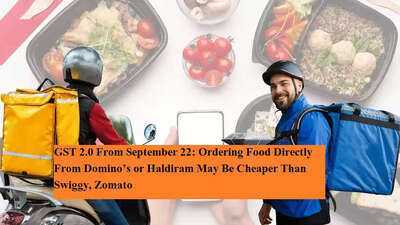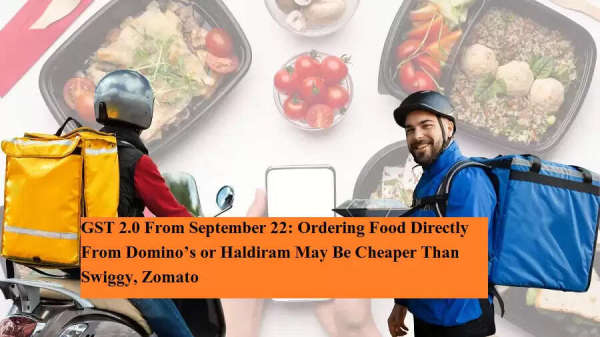

If you are someone who frequently orders food online, here’s an important update. Starting September 22, 2025, the cost of food delivery will change under the new GST 2.0 framework. The new tax rules mean that ordering directly from restaurants like Domino’s, Haldiram, or Nazeer will be cheaper compared to ordering via third-party apps such as Swiggy and Zomato.
What Changes Under GST 2.0?As per the updated GST guidelines, food delivery platforms will now attract a flat 18% GST on deliveries, while direct restaurant orders will continue to be taxed at only 5%.
Direct restaurant order (via call, website, or official app): 5% GST
Food ordered via delivery apps (Swiggy, Zomato, etc.): 18% GST
This means the same food item will cost significantly more if ordered through aggregator apps than if bought directly from the restaurant.
Why Ordering Directly Will Be CheaperCustomers who place orders directly through a restaurant’s website, app, or phone will only pay the regular 5% GST, without any hidden or extra charges. In contrast, orders placed via platforms like Swiggy or Zomato will now include an 18% GST on the delivery service, which delivery partners are required to collect.
Naturally, this cost will not be absorbed by the delivery companies. Instead, it will be passed on to customers in the form of:
Higher delivery charges, or
Increased food prices on the app itself
Industry experts estimate that delivery companies may collectively face an additional annual tax burden of over ₹200 crore, which will ultimately fall on consumers.
Likely Impact on CustomersFor customers, this means an important choice:
Save money by ordering directly from restaurants.
Pay extra for the convenience of doorstep delivery through Swiggy or Zomato.
While aggregator apps still provide unmatched convenience, regular users may now rethink their ordering habits to cut costs, especially for frequent or bulk orders.
Boost for RestaurantsThis change could benefit restaurant owners who have long complained about heavy dependency on food delivery platforms and the commission structures involved. With the new GST rule, many customers may prefer to contact restaurants directly, boosting direct sales and reducing reliance on third-party apps.
This is particularly good news for restaurants that have invested in their own websites, apps, or direct delivery systems.
History of Restaurant-App DisputesThe conflict between restaurants and delivery platforms is not new. In 2019, the National Restaurant Association of India (NRAI) launched a “Logout Campaign” against online food aggregators, protesting against high commissions and deep discounting policies.
With the new GST clarification, restaurants once again have an edge, as they can offer lower-cost food compared to app-based delivery.
GST Council Clears the AirThe matter had been under discussion for quite some time. Finally, during the 55th GST Council meeting, it was clarified that e-commerce operators providing delivery services will be charged 18% GST. This decision removes ambiguity and sets a clear distinction between direct restaurant sales and aggregator-based deliveries.
Final TakeawayFrom September 22, 2025, the food delivery game changes for Indian consumers. Ordering directly from restaurants like Domino’s, Haldiram, or Nazeer will be significantly cheaper than relying on platforms like Swiggy or Zomato.
While convenience will continue to drive demand for aggregator apps, price-sensitive customers are likely to shift towards direct orders. For restaurants, this could mean stronger customer relationships and reduced dependence on third-party platforms.
In short, GST 2.0 is not just a tax change—it’s a shift in how India may choose to order food online.